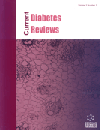- Home
- A-Z Publications
- Current Diabetes Reviews
- Issue Home
Current Diabetes Reviews - Current Issue
Volume 21, Issue 9, 2025
-
-
An Updated Review on Diabetic Nephropathy: Potential Mechanisms, Biomarkers, Therapeutic Targets and Interventional Therapies
More LessBackgroundDiabetic nephropathy (DN), the primary risk factor for end-stage kidney disease (ESKD) that requires dialysis or renal transplantation, affects up to 50% of individuals with diabetes.ObjectiveIn this article, potential mechanisms, biomarkers, and possible therapeutic targets will be discussed, as well as their interventional therapies.MethodsA literature review was done from databases like Google Scholar, PUBMED-M Read More
-
-
-
Exploring the Therapeutic Potential of Anti-VEGF Drugs for the Management of Diabetic Retinopathy: An Overview
More LessAuthors: Aman Khandelwal, Kuppusamy Gowthamarajan, Jayabalan Nirmal and S. PonnusankarThe discovery of antivascular endothelial growth factor medications has resulted in a substantial change in diabetic retinopathy treatment. The most common cause of diabetic retinopathy blindness is Diabetic Macular Edema. The pathophysiology of Diabetic Macular Edema is thought to include the well-known pro-angiogenic and pro-permeability factor vascular endothelial growth factor. Over the past decade, drugs that Read More
-
-
-
Impact of SGLT2 Inhibitors on Renal Function in Type 2 Diabetic Patients with Coronary Artery Disease Undergoing Percutaneous Intervention: A Systematic Review and Meta-Analysis
More LessBackgroundContrast agents directly cause kidney toxicity in patients who are candidates for percutaneous intervention having cardiovascular disease with type 2 diabetes.AimsThis meta-analysis aims to assess the effects of SGLT2i on renal function in individuals undergoing percutaneous intervention.MethodsThe databases used for the search included Google Scholar, PubMed, Cochrane Central Registry of Controlled Trials Read More
-
-
-
Integration of Diabetes Mellitus and Hypertension on Major Cardiovascular Events: An Experience From a 15-year Follow-up Cohort Study in EMR
More LessIntroductionPatients with hypertension and diabetes are more susceptible to cardiovascular diseases (CVD) and mortality. This study aimed to evaluate the individual and combined effects of hypertension and diabetes on cardiovascular events and mortality in a Middle Eastern population-based cohort.MethodsFifteen-year follow-up data were collected for 6323 adults aged 35 years and older who were free from CVD at ba Read More
-
-
-
Diabetes and its Silent Partner: A Critical Review of Hyperinsulinemia and its Complications
More LessIn this complex realm of diabetes, hyperinsulinemia is no longer regarded as just a compensatory response to insulin resistance but rather has evolved into an integral feature. This comprehensive review provides a synthesis of the current literature, including various aspects associated with hyperinsulinemia in diabetic complications. Hyperinsulinemia has been shown to be more than just a compensatory mechanism, and the Read More
-
-
-
The Effect of a Vegan Diet on the Health Indicators and Outcomes of Patients with Type 2 Diabetes Mellitus
More LessIntroductionRecently, there has been a notable increase in interest in various forms of vegetarianism, which may be due to the growing prevalence of health issues, such as Type 2 Diabetes Mellitus (T2DM). Adhering to a vegan diet may have positive health outcomes. As a result, we conducted a review article to gather data from previous research studies on the effects of a vegan diet on different aspects of managing patients wit Read More
-
-
-
The Role of Dietary Anthocyanins for Managing Diabetes Mellitus-Associated Complications
More LessDiabetes mellitus (DM) is an intricate metabolic disorder marked by persistent hyperglycemia, arising from disruptions in glucose metabolism, with two main forms, type 1 and type 2, involving distinct etiologies affecting β-cell destruction or insulin levels and sensitivity. The islets of Langerhans, particularly β-cells and α-cells, play a pivotal role in glucose regulation, and both DM types lead to severe complications, including retino Read More
-
Volumes & issues
-
Volume 21 (2025)
-
Volume 20 (2024)
-
Volume 19 (2023)
-
Volume 18 (2022)
-
Volume 17 (2021)
-
Volume 16 (2020)
-
Volume 15 (2019)
-
Volume 14 (2018)
-
Volume 13 (2017)
-
Volume 12 (2016)
-
Volume 11 (2015)
-
Volume 10 (2014)
-
Volume 9 (2013)
-
Volume 8 (2012)
-
Volume 7 (2011)
-
Volume 6 (2010)
-
Volume 5 (2009)
-
Volume 4 (2008)
-
Volume 3 (2007)
-
Volume 2 (2006)
-
Volume 1 (2005)
Most Read This Month Most Read RSS feed
Article
content/journals/cdr
Journal
10
5
false
en


